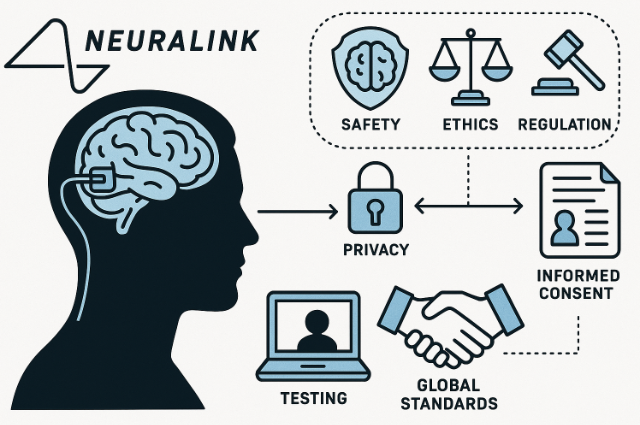
Elon Musk's Neuralink is a company that is trying to do something very big and new, connect the human brain with computers. This idea sounds amazing, but it also brings up a lot of questions and problems, especially when it comes to rules and safety.
Neuralink is working on creating tiny devices that can be put inside a person's brain.
They might also help those with spinal cord injuries.
Imagine being able to learn faster, remember more, or think more clearly. BCIs could potentially boost our natural brain abilities.
With a BCI, you might be able to send messages to other people just by thinking about them, or control your phone or computer without touching it.
Why Are Rules So Important?
Putting a device inside someone's brain is a very serious matter. Because of this, there are many rules and laws that companies like Neuralink need to follow. These rules are there to protect people.
Here are some of the main problems Neuralink faces when it comes to rules.
Any time you put something into the body, there's a risk. With brain implants, there could be problems like infections, damage to the brain tissue, or other bad effects that show up much later. Regulators need to be sure these devices are safe before many people use them.
If we can change how human brains work, what does that mean for us as people? Will it change who we are? What about our thoughts and feelings? These are deep questions about what is right and wrong, and regulators need to think about them carefully. For example, if a BCI can change your memory, is that a good thing? What if someone could access your thoughts?
- Privacy of Brain Data: When a BCI is connected to your brain, it will collect a lot of information about your thoughts and brains." How will it be kept private? Could it be stolen or misused? Protecting this very personal information is a huge challenge.
- Rules Are Old, Technology Is New: The laws and rules we have for healthcare were made a long time ago, before anyone dreamed of connecting brains to computers. These old rules might not be strong enough or flexible enough to handle such new and fast-changing technology.
Technology and new discoveries are happening soon, or quickly. But making new laws and rules takes a long, long time.
This means that by the time a new rule is made for a technology, the technology might have already moved on or changed significantly. This can slow down good ideas or lead to rules that aren't quite right. For Neuralink, it means finding a way to allow them to keep innovating and discovering new things while still making sure people are safe. It's a tricky balance.
How to solve problems?
To deal with these big challenges, many different groups of people need to work together. This includes scientists who are inventing these devices, people who think about right and wrong (ethicists), the people who make and enforce the rules (regulators), and the people who make laws (policymakers).
Rules: Instead of very strict and unchanging rules, we need rules that can bend and change as the technology grows. These "flexible frameworks" would allow for new discoveries while still keeping people safe. They might focus more on the principles of safety and ethics rather than prescribing exact technical details that could quickly become outdated.
Clear Guidelines: We need clear rules about what is considered ethical and what is not when it comes to BCIs. For example, what are the limits to enhancing human abilities? How do we make sure these technologies are used for good and not for bad? These guidelines will help everyone involved understand the moral boundaries.
Testing: Before these devices can be widely used, they need to be tested very, very carefully by people. These "clinical trials" must be very strict and open. This means everyone should be able to see how the tests are done and what the results are. This helps build trust and makes sure the devices really work and are safe.
Informed Consent and Patient Rights: When someone agrees to have a BCI implanted, they need to understand everything about it. This is called "informed consent." And even after they receive the device, their rights as a patient must always be protected.
Working Together Globally: Because technology doesn't stop at borders, different countries need to work together. If countries have very different rules, it can make it hard for companies to develop these technologies and for people to get the benefits. Establishing "global standards" means everyone agrees on the basic rules, which can help make these technologies safer and more available worldwide.
It's a big step into a future where humans and machines will be more connected than ever before. While the idea of helping people with disabilities or even making our brains better is very exciting, we can't ignore the serious problems that come with it.
By carefully dealing with the issues of rules, ethics, and safety, we can make sure that these brain-computer interfaces are used in a way that helps people live better lives. We must also make sure that we always respect human rights and the dignity of every person as we move into this new technological age. It's a journey that requires careful thought, open discussion, and a commitment to doing what's right.
